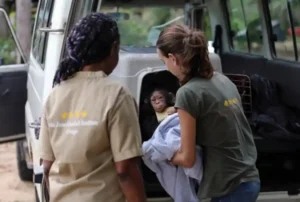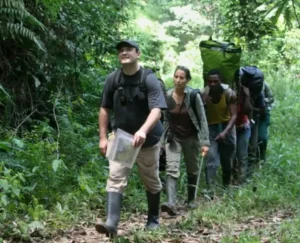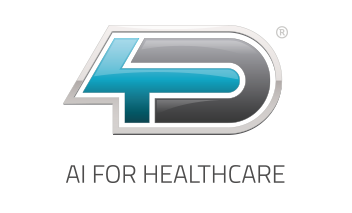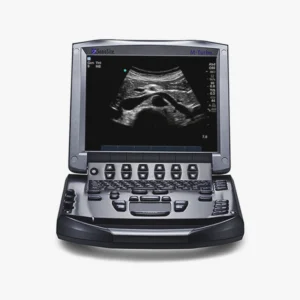At 4D MedicaWe believe that innovation and medical technology must go where it is needed most. In our commitment to animal health, conservation and welfare, we have made an innovative collaboration with the Jane Goodall Institute. Specifically, with its Chimpanzee Rehabilitation Center of Tchimpounga (CRCT)located in the Republic of Congo.
Since its founding 30 years ago, the Jane Goodall Institute has had a key role in chimpanzee rescue and rehabilitation. Currently, this center represents the largest chimpanzee sanctuary in Africa. and is directed by Spanish veterinarian Rebeca Atencia. It is home to more than 140 orphaned chimpanzees rescued from illegal trafficking and poaching.
In this initiative, we have provided different medical equipment specialized with the objective of to promote better veterinary care. When the chimpanzees arrive at Tchimpounga, they are traumatized and require urgent veterinary assistance. In this area, medical technology is a fundamental resource to facilitate their rescue and rehabilitation process. And, subsequently, to give them the opportunity to be released back into their natural habitat.
Tchimpounga Chimpanzee Rehabilitation Center, the largest chimpanzee sanctuary in Africa.
Founded in 1992the Chimpanzee Rehabilitation Center of Tchimpounga (CRCT) is one of the world's leading centers for the rehabilitation of chimpanzees. Jane Goodall Institute's main initiatives in Africa. Located in the coastal region of Congo, the center was created in response to an alarming increase in illegal primate trafficking, which left hundreds of orphaned and traumatized offspring. It is located within the Tchimpounga Nature Reserve.which covers more than 520 km² and is home to wild chimpanzees and other endangered animals.
In the beginning, it started as a modest shelter, but has now evolved to become a international benchmark in chimpanzee rehabilitation. The center's mission is clear: to rescue, rehabilitate and offer a dignified life to chimpanzees that are victims of human exploitation.

A new paradigm in chimpanzee rehabilitation
In the 2010s, one of the most relevant milestones in the history of the center was its expansion into three river islands in the Kouilou River: Tchindzoulou, Ngombe and Tchibebe.. This initiative revolutionized the approach to chimpanzee rehabilitation. In this way, the animals were able to live in a more natural, safe and free environmentThey continued to receive veterinary support and monitoring from the Jane Goodall Institute team.
Why were the river islands of the Kouilou River chosen?
The three islands in the Kouilou River - Tchindzoulou, Ngombe and Tchibebe - were strategically chosen for several reasons:
- They are surrounded by waterThis prevents chimpanzees from escaping without the need for artificial fences.
- Rich in biodiversity and vegetationThis favors a semi-wild life with natural behaviors such as foraging, nest building and free play.
- Its location close to the main center facilitates access for veterinary staff and caretakers to supervise, care for and feed the chimpanzees when necessary.
Since their inception, these islands have become the most important final home of many rehabilitated chimpanzeesthat for various reasons (previous trauma, illness or age) cannot be reintroduced in total freedomThey can, however, enjoy a dignified, social existence in contact with nature. Currently, on the islands live in structured chimpanzee groups with stable social hierarchieswhere they can develop behaviors similar to those observed in the wild:
- They are fed of wild fruits, leaves and seeds.
- Free to move through the tropical rainforest.
- Form complex social bondswith games, alliances and hierarchies.
- They build nests in trees every night to sleep.
This model of semi-liberty has not only improved the quality of life of chimpanzees, but has also strengthened scientific research on their behavior in conditions close to their original habitat.

Medical technology at the service of animal welfare
As part of our collaboration with the Jane Goodall Institute, from 4D Medica we have provided medical equipment diagnostic imaging tailored to the specific needs of the Tchimpounga site. These tools help improve veterinary care in the following areas:
- Detect diseases respiratory, digestive or musculoskeletal disorders with greater precision.
- Perform non-invasive diagnostics to reduce stress in animals.
- Monitoring the evolution of chimpanzees recovering after trauma or infectious diseases.
- Planning surgical interventions or treatments more safely and efficiently.
Thanks to this technology, veterinarians can provide more comprehensive care, improving both the recovery rate and the quality of life of the animals throughout their rehabilitation process.
A road to freedom: The rehabilitation phases at Tchimpounga
The remediation process at the Tchimpounga Center aims not only to restore the chimpanzees' physical health, but also to heal their emotional traumas and reintegrate them into stable, natural communities. It is a complex and delicate process, designed to respect the rhythm of each animal, offering them a second chance at life. This process takes place in four fundamental phases:
1. Quarantine and intensive care phase
Upon arrival at the center, the chimpanzees go through a strict quarantine lasting at least 90 days. During this period, they receive complete and intensive veterinary care. Many of the animals arrive injured, malnourished or sick after being rescued from illegal trade or situations of mistreatment. Therefore, at the beginning, it is important to assess their general condition in order to stabilize and reassure them.
At this stage, the use of appropriate medical equipment is essential for an accurate diagnosis. to determine if there are injuries or illnesses and to plan the treatment to be followed in their rehabilitation.
2. Initial socialization and bonding phase
Once the quarantine is over, the youngest chimpanzees are integrated into living groups with other animals of similar age groups. It is at this time that they begin to acquire natural behaviors after contact with their peers and the support of specialized caregivers. It is therefore a fundamental stage in their development. social and emotional development.
3. Integration phase in stable communities
After a progressive adaptation phase, chimpanzees are introduced into stable social groups that mimic the natural dynamics of wild clans. These communities live in large forest enclosures within the sanctuarywhere they can move freely, climb, forage, establish hierarchies and form complex bonds.
4. Semi-freedom phase in the Tchimpounga Islands.
The final step of rehabilitation is the relocation of chimpanzees to the protected islands of the Kouilou riverwhich are part of the center's reserve. There, the chimpanzees can live in almost wild conditions, protected from human threatsbut with the necessary follow-up by the Jane Goodall Institute team. After this rehabilitation process, many of them fully recover their autonomy and have a second chance to live in an environment similar to their natural habitat.
Veterinary medical equipment supplied by 4D Medica
Through the contribution of veterinary medical equipment by 4D Medica, the Tchimpounga team has been able to further professionalize veterinary care in the rescue and rehabilitation process of the chimpanzees. This has boosted faster and more reliable diagnostics, safer and more efficient treatmentsas well as a precise monitoring of its evolution. The different devices supplied are described below:
Dry biochemistry equipment
It is a compact and efficient clinical analysis systemdesigned for environments with limited resources. By using this equipment, the following can be performed biochemical blood tests quickly and reliably, facilitating accurate field diagnostics.
Wireless digital X-ray detector Vivix-V2430
This medical equipment is a portable digital radiography detector. It has wireless connectionIt is suitable for environments where mobility plays a key role. It offers high-resolution images at high speedThe results of this study have been shown to improve the detection of fractures, bone anomalies or pulmonary problems.
Wired digital X-ray detector Vivix-V3543
Offers a robust high-resolution X-ray system and is designed for intensive clinical use. Its accuracy and integration capabilities make it a key tool for advanced veterinary diagnostics.
Sonosite M-Turbo portable ultrasound scanner
It is a high-performance portable ultrasound scanner. Among its main features, it stands out for its portability, durability and image quality in the field. It is used to perform minimally invasive abdominal, musculoskeletal and cardiac examinations.
Meet our medical team
Technology, commitment and conservation: A necessary alliance to achieve animal welfare
The collaboration between 4D Medica and the Jane Goodall Institute is an example of how technological innovation can be integrated with conservationcreating a real impact on the lives of animals. Every chimpanzee that walks freely in the forest again and every early diagnosis that saves a life is also part of our purpose.
Because, in the end, medicine not only treats bodies, it also repairs lives.
Bibliography
Jane Goodall Institute Spain (n.d.). Tchimpounga Chimpanzee Rehabilitation Center. https://janegoodall.es/es/centrodetchimpounga.html
Jane Goodall Institute Spain (n.d.). Phases of chimpanzee rehabilitation. https://janegoodall.es/es/fases.html
Jane Goodall Institute Spain (n.d.). Mission and history. https://janegoodall.es/es/misionehistoria.html
Jane Goodall Institute Spain (2022, November 2). Our rescue center in Congo celebrates its 30th anniversary. https://janegoodall.es/news/es/2022/11/02/0001/nuestro-centro-de-rescate-en-congo-cumple-30-anos
Sonosite (n.d.). Sonosite M-Turbo Ultrasound System. https://www.sonosite.com/la/products/sonosite-m-turbo



